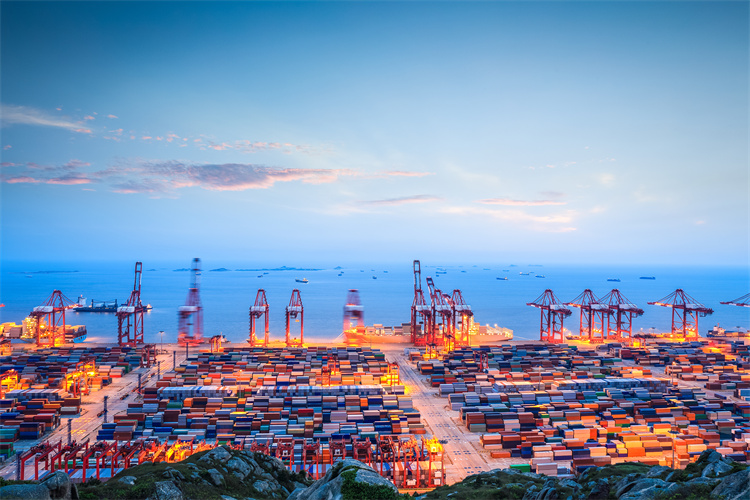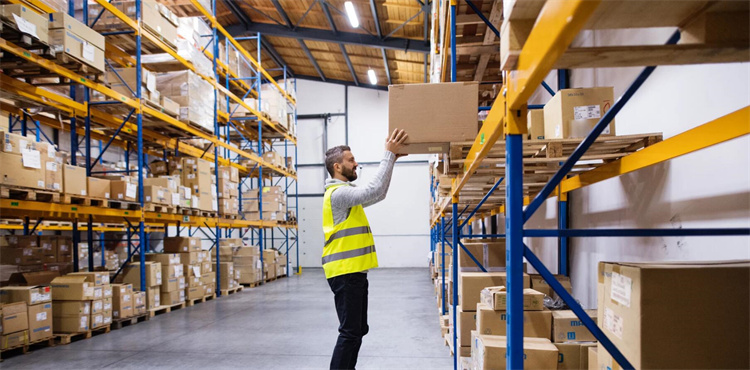Top 10 Technology Solutions for End-to-End Visibility in 2025

You need end-to-end visibility to keep your global supply chain strong in 2025. Many leaders agree:
57% say visibility drives tech investments.
Digital transformation helps logistics work better. Companies like Amazon use AI, big data, and observability to guess demand and make logistics better. JUSDA leads with new solutions. JusLink gives observability, real-time logistics tracking, and smart solutions to your supply chain. Observability tools help you find gaps. Ask yourself if your logistics have full observability and if your solutions are ready for the future.
Key Takeaways
End-to-end visibility helps you see risks. It makes work easier. It helps you make good choices in your supply chain.
Advanced technologies like AI, IoT, blockchain, and cloud platforms give real-time data. They help you watch shipments. They help you guess demand. They help you control risks.
Using tools like JUSDA’s JusLink platform lets you watch your whole supply chain. You can fix problems fast. You can stay ready for new challenges.
End-to-End Visibility Trends

Business Drivers
New business drivers are changing end-to-end visibility in 2025. Companies want better observability and monitoring for strong logistics. Real-time data and metrics help track each step. Cloud platforms connect systems and share data fast. Over 68% of organizations see better visibility with cloud solutions. AI and machine learning help make better forecasts and stop problems. These tools help you see trends and act quickly. IoT devices give more observability by tracking assets and checking the environment. Blockchain technology makes things more clear and easy to trace. This helps meet safety and compliance rules. Sustainability is important too. Observability tools help watch environmental metrics and support green logistics. ESG goals are now a bigger focus. You want to protect revenue, save money, and stay flexible. Real-time monitoring and data-driven metrics help you make smart choices and match logistics to your business goals.
Tip: Use one dashboard to see all your data, metrics, and observability tools. This helps you make better decisions.
Risks and Challenges
There are many risks if you do not have end-to-end visibility. Broken data and weak observability make it hard to watch logistics and fix problems. Many companies only see their first suppliers and miss deeper risks. Without good monitoring, it is hard to track metrics and find issues early. Data silos slow down your response to problems. You might not see inventory shortages or quality problems. Cyberattacks are a bigger risk if you cannot watch third-party partners. Not enough staff and small budgets can stop you from getting better observability. You need better tools and connected data to fix these problems. Only 6% of companies have real end-to-end visibility. Most still use manual work, which limits observability and slows monitoring. To do well, you must break silos, connect data, and use advanced monitoring tools. This helps you handle logistics risks, improve metrics, and keep your supply chain strong.
JUSDA JusLink Platform
JusLink gives you strong tools for end-to-end visibility. You can use observability tools to watch every part of your supply chain. The platform uses microservices to link systems and make software observability better. You can see real-time updates for shipments, inventory, and orders. JusLink helps you find problems early with observability tools and full-stack observability. You get live metrics that show how your supply chain is working. Microservices help make observability simple and flexible. You can change the tools to fit your business needs. JusLink is special because it brings together RFID, warehouse management systems, and predictive analytics. This mix gives you better monitoring and observability than other platforms. You can work together quickly and make smarter choices with these tools.
AI Forecasting
AI forecasting helps you guess demand and plan inventory. JusLink’s observability tools let you see sales trends and market changes. The platform uses microservices to run forecasting models and share metrics. You get alerts from monitoring tools when demand changes. JusLink’s software observability lets you change plans fast. You can use observability tools to check inventory and stop shortages. The AI forecasting feature gives you strong metrics for planning. You can see how changes affect your supply chain with real-time monitoring.
Risk Control Tower
JusLink’s Risk Control Tower gives you strong monitoring and observability. You can track risks with observability tools and get alerts for problems. The platform uses microservices to connect risk data and make software observability better. You can see metrics for transport, customs, and inventory risks. JusLink’s monitoring tools help you act fast when there are problems. You can use observability tools to check risk levels and make smart choices. The Risk Control Tower uses microservices to keep your monitoring flexible and strong. You get better observability and control with these solutions.
IoT and Sensor Networks

Real-Time Tracking
IoT and sensor networks help you track deliveries better. These tools let you see where every shipment is right now. The logistics IoT market is getting bigger each year.
In 2022, the market was $44.6 billion and keeps growing fast.
Manufacturing uses over one-third of global IoT spending, and 58% of manufacturers say IoT is key for digital change.
By 2025, IoT is common in logistics for tracking, fixing things before they break, and smart warehouses.
IoT sensors tell you where shipments are and how they are doing. You can check temperature, humidity, and safety with these tools. Real-time data helps you find delays and fix them quickly. Geo-fencing can stop theft and sends alerts if a shipment goes off course. These tools help you solve problems before they get big. Last mile delivery software lets your team use IoT data to update customers. Companies like Amazon and DHL use these tools to make shipments more accurate and faster.
Warehouse Observability
Sensor networks help you watch what happens in your warehouse. You can use tools to track inventory, equipment, and work steps. These tools help you find and fix problems fast.
Watching all the time means better data and less downtime.
Automated alerts tell you right away if data is missing or strange.
Teams can share tools and health data to work together better.
You can use these tools to look at old data and see patterns. Monitoring helps you spot odd things and make sensors work better. Last mile delivery software connects warehouse data to your delivery network. These tools make your warehouse stronger and able to grow. Observability helps you use machine learning and analytics for smarter choices. Monitoring also makes work easier and saves time on fixing problems. With good observability, your warehouse runs well and helps your whole supply chain.
Cloud Supply Chain Solutions
Integration
Cloud supply chain solutions help you link old systems to new technology. You can use different ways to do this. Some companies use point-to-point connections for easy links. Others pick middleware or cloud platforms for harder jobs. The table below shows common ways to connect legacy systems with cloud solutions:
Integration Method | Description | Advantages | Challenges |
|---|---|---|---|
Point-to-Point | Direct links between two systems | Simple setup | Hard to scale |
Middleware (ESB, iPaaS) | Central hub for data and process flow | Flexible, reusable | Extra cost and management |
API-based | Uses APIs to share data and functions | Modern, easy to update | Needs code changes |
Phased Implementation | Step-by-step upgrades | Low risk, easy to manage | Takes more time |
You should check your systems before you start. Use middleware to fill gaps and keep data safe. Planning and testing help you stop problems. Cloud supply chain solutions let you use old systems and add new features like last mile delivery software.
Scalability
Cloud supply chain solutions grow as your business grows. You do not need to buy new hardware or wait for upgrades. You can add users, places, or features fast. This helps you handle busy times like holidays or big sales. Cloud platforms let you start small and get bigger when you need. Many companies pick cloud solutions because they are flexible and save money.
You can set up new warehouses or offices in days.
Cloud systems help teams work together in real time.
You get better disaster recovery and business continuity.
Cloud solutions support quick changes and new analytics tools.
With cloud supply chain solutions, you can handle growth and change easily. These platforms help you get ready for new challenges and keep your supply chain strong.
Blockchain Transparency
Data Sharing
You need good observability to share data in your supply chain. Blockchain gives you one place for all the data. Every transaction goes into a shared record. This record helps you see every data change right away. You do not have to worry about lost or changed data. Everyone in your group gets the same data, so trust gets stronger.
Here is how blockchain helps with data sharing and observability:
Benefit/Feature | Explanation |
|---|---|
Immutable Shared Ledger | Keeps every transaction, so changing data is almost impossible. |
Real-time Visibility | Lets you watch supply chain steps right away and find slow spots. |
Improved Traceability | Follows products back to where they started, making it easier to see and stopping fraud. |
Smart Contracts | Makes some jobs automatic, so there is less paperwork and fewer mistakes. |
You can use blockchain with IoT devices. This lets you watch things like temperature and location. Smart contracts help make payments and shipments automatic. You get better observability and can fix problems faster. Blockchain also helps you follow rules by keeping a clear record of all data.
Security
Blockchain gives you strong security and observability for your supply chain. The system uses codes to keep data safe. You can trust that no one can change data without others knowing. Observability tools help you watch every step, so you can find fraud or mistakes fast.
Blockchain makes a record that cannot be changed, so fake products are hard to add.
Smart contracts make sure rules are followed and jobs are done right, so there are fewer mistakes.
Everyone sees the same data, which helps observability and trust.
Decentralization means no single spot can fail, so your data is safer.
You can use blockchain to check if products are real and track them from start to finish. Observability gets better because you see every transaction and data change. This helps you find problems early and keep your supply chain safe. Companies like Walmart use blockchain to track food safety, showing how observability and data safety work together. With blockchain, you get good ways to share data, watch your supply chain, and keep it secure.
Digital Twin Technology
Simulation
Digital twin technology lets you make a virtual copy of your supply chain. This copy helps you watch every part of your work. You can see how goods move and where things slow down. You also see how resources move through the system. Digital twins use real-time data to show what is happening now. You can try new ideas safely before changing things for real. For example, you can change truck routes or move things in the warehouse. You can see what happens when you do this. This helps you find the best way to do your job. Digital twins help you spot problems early by using data. You can watch how your supply chain acts during different events. This kind of observability helps you make better choices and avoid mistakes.
Here is a table that shows how companies use digital twins and what they get from it:
Key Adoption Indicators and Benefits | Details / Statistics |
|---|---|
Software Segment Dominance | Over 65% market share in 2023 |
Cloud Deployment Preference | Over 70% market share in 2023 |
Warehouse Productivity Improvement | 30% to 40% increase with AI-enhanced digital twins |
Revenue and Efficiency Gains | Revenue up 10%, time to market faster by 50% |
Operational Impact | 85% of planning automated by procurement teams |
Digital twins use observability and data to help you plan, test, and make your supply chain better.
Predictive Insights
Digital twins give you predictive insights by using observability and data together. You can see what might happen before it does. The system uses real-time data and past trends to guess risks and changes in demand. You can model problems like late suppliers or broken equipment. This helps you get ready for trouble before it gets worse. Digital twins send alerts when data shows a risk is coming. You can act fast to fix problems. Observability lets you track inventory, shipments, and how suppliers are doing all at once. You can use data to try new plans and see which one works best. Digital twins help you keep your supply chain strong and ready for change. You get better control, fewer surprises, and more confidence in your choices.
Tip: Use digital twins to bring observability and data together for smarter and faster supply chain management.
Advanced ERP Systems
Process Automation
Advanced ERP systems help you automate supply chain jobs. Automation makes it easier to manage inventory and orders. You do not need to do as much manual work. This means fewer mistakes and more time saved. ERP systems connect your teams and partners. Everyone can see the same data. This helps people talk to each other and work better together.
Automation lets you track shipments and inventory in real time. You get alerts when stock is low or orders need help. These systems use analytics and metrics to help you plan. You can guess what you will need and fix problems before they happen. Automation helps you follow rules and keep things safe. Using ERP automation saves money and makes customers happier.
Here are ways ERP process automation helps your supply chain:
Cuts down on manual work and mistakes.
Gives you real-time control and visibility.
Helps you work better with suppliers.
Helps you follow rules and manage risks.
Grows with your business as you get bigger.
Data Observability
Data observability is important in modern ERP systems. You need to see your supply chain data right away to make good choices. ERP systems collect data from many places and show it together. This helps you find problems early and fix them fast.
With strong data observability, you can track inventory, shipments, and production at every step. Real-time monitoring shows if something goes wrong, like a late shipment or low stock. You can use analytics to find patterns and make your supply chain better. Metrics help you check how your team is doing and set goals.
Tip: Use dashboards to watch important metrics and data trends. This helps you act fast and keep your supply chain working well.
Here is a table that shows how ERP features help supply chain visibility:
ERP Feature / Capability | How It Supports Visibility and Observability |
|---|---|
Integrated Data Management | Puts all data in one place for easy oversight. |
Real-Time Tracking | Shows current inventory, shipments, and production. |
Demand Forecasting | Uses data to guess needs and stop shortages. |
Supplier Collaboration | Shares data for better teamwork and observability. |
Warehouse Management | Tracks inventory and storage in real time. |
Analytics | Gives insights and metrics for smart choices. |
Compliance Management | Automates checks and tracks compliance. |
Integration with Logistics Software | Connects data for real-time shipment tracking. |
Scalability and Flexibility | Grows with your business and adapts to new needs. |
When you use data observability in your ERP, you get better control, faster fixes, and a stronger supply chain.
Unified Dashboards
Visualization
Unified dashboards help you see your supply chain clearly. All your data is in one spot. This makes it easy to use observability and find problems. You can also see trends as they happen. The best dashboards have many ways to show data. You might see bar charts or line charts to watch changes over time. Pie charts and donut charts show how parts compare. Scatter plots and heat maps help you spot patterns in your metrics. Gantt charts let you follow project schedules step by step. Network diagrams show your supply chain and where risks might be. Geospatial maps help you track shipments and inventory live. These tools make observability simple and useful. Interactive dashboards let you click and explore your data. You can check inventory, shipping, and how suppliers are doing. Good visualization tools help you act fast and keep things running well.
Decision Support
Unified dashboards help you make better choices every day. You get real-time observability for your whole supply chain. All your data comes together, so you do not miss anything. You can use metrics to track shipments, inventory, and how suppliers are doing. These tools help you find bottlenecks and fix them fast. AI-powered dashboards use observability to warn you early and test ideas. You can try out plans and see what works best. Automation in dashboards cuts down on manual work and helps you respond quickly. You can see costs and risks right away. This helps you save money and avoid trouble. Unified dashboards give you one true view of your supply chain. You can use observability, data, and metrics to make smart, quick choices. These tools help your supply chain stay flexible and work better.
Edge Computing
Local Processing
Edge computing lets you handle data near where it starts. You do not need to send all data to a main server. This makes things faster and helps you see what is happening. Local processing means you do not use as much cloud storage. It also lowers network costs for your business. You can make choices quickly because data stays close by. For example, sensors in a warehouse use edge computing to check inventory. They can send alerts right away if something changes. This helps you watch things and keeps your supply chain working well. You can sort and study data at the edge. This makes it easier to see what is going on and helps your system work better.
Edge computing lets you watch things in real time.
Local processing helps you find problems quickly.
You see data right when it is made, so observability is better.
You save money by only sending important data to the cloud.
Watching things at the edge helps you track shipments and assets.
Real-Time Observability
Edge computing gives you real-time observability that is very strong. You can watch your supply chain and react fast to changes. Edge devices let you check shipments, equipment, and inventory right away. This cuts down on waiting and helps you act quickly. You can use AI at the edge for smart guesses and planning. This makes observability stronger and helps you get ready for the future. Edge computing keeps monitoring going even if the network stops working. Your work stays safe and reliable. You can add more edge devices to grow your system. This makes observability and watching things better everywhere.
Benefit | How It Helps Your Supply Chain |
|---|---|
You get instant alerts and updates | |
Better observability | You see data from every supply chain step |
Lower costs | You use less bandwidth and storage |
Stronger security | You keep sensitive data local |
Improved reliability | You keep monitoring during outages |
Tip: Try edge computing to help with observability and monitoring. It works well for jobs that need fast action, like fleet management and predictive maintenance.
Automated Workflow Tools
RPA Integration
You can use automated workflow tools to make your supply chain smarter. Robotic Process Automation (RPA) helps you handle tasks that take a lot of time. These tools watch your processes and use monitoring to spot steps that can be automated. You set up RPA to copy what people do on computers. The tools can move data, send alerts, and update records. With RPA, you get better observability because the tools track every action. Monitoring shows you where the tools work best. You can see how RPA changes your workflow and helps you find weak spots. These tools also connect with other systems, so you get more observability and better monitoring.
RPA tools help you keep an eye on your supply chain. You can use monitoring to check if the tools work right. Observability lets you see how each tool affects your results.
Efficiency Gains
Automated workflow tools give you big efficiency gains. You save time because the tools do jobs faster than people. Monitoring helps you see where you get the most value. Observability lets you track how tools improve your supply chain. You can use these tools to cut down on mistakes. The tools help you follow rules and keep your data safe. With good monitoring, you spot problems early. Observability shows you trends and helps you plan better. You can use tables to compare how tools change your work.
Benefit | How Tools Help |
|---|---|
Faster work | Tools finish tasks quickly |
Fewer mistakes | Monitoring finds errors fast |
Better planning | Observability shows trends |
You get more control with these tools. Monitoring and observability make your supply chain strong and ready for the future.
Choosing Solutions
Assessment
You need to start by looking at your current supply chain and what you want to achieve. Ask yourself if your team can handle new technology and if your data is ready for change. Good solutions help you move past old ways and give you real-time insights. You should look for solutions that use cloud computing, AI, and advanced analytics. These tools help you collect, connect, and study data from every part of your supply chain.
Here is a simple list to help you assess solutions:
Check if your data is standard across all teams and partners.
Make sure the solutions map your whole supply chain, not just one part.
Pick solutions that connect different systems and give you strong analytics.
Set clear goals and use data to measure results.
Choose solutions that help you share data with suppliers and customers.
You should also look for solutions with IoT, blockchain, and digital twins. These tools help you see data in real time and keep your supply chain safe.
Implementation
When you pick solutions, plan how you will use them. Start with a clear goal and make sure your team knows how to use the new tools. JUSDA uses a step-by-step method. They connect data from many sources and help teams work together. Their JusLink platform shows how strong solutions can bring real-time data, smart analytics, and better teamwork.
You can learn from JUSDA’s customer stories. For example, Sharp used JUSDA’s solutions to cut costs and improve data accuracy. Good solutions help you act fast, fix problems, and keep your supply chain strong.

JUSDA Solutions
To provide you with professional solutions and quotations.
You need observability to keep your supply chain strong in 2025. Observability lets you watch shipments and find risks early. It helps you make better choices for your business. JusLink gives you observability with live data and smart tools. JUSDA is a leader in observability and efficiency. Check where you need more observability and pick advanced solutions for the future.
See Also
Exploring How AI Will Transform Tomorrow’s Supply Chains
Improving Supply Chain Efficiency Through Cloud-Based Tools
The Impact Of Cloud Solutions On Industry Supply Chains
